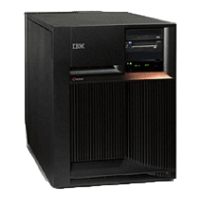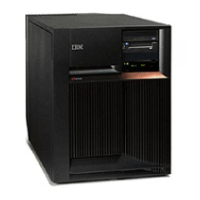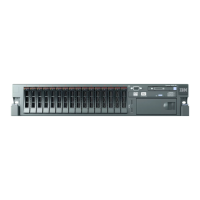Cryptographic I/O processor
For use by authorized service providers.
This information applies to Models 830, 840, SB2, and SB3 only.
Attention: The type 2620 or type 2628 cryptographic I/O processor should not be removed or
disconnected except by qualified IBM service personnel. Performing this action for any reason causes the
loss of the primary encryption key.
Before disconnecting or removing the cryptographic I/O processor, ensure that the customer has access to
a record of the primary encryption key. After any service action that involves disconnecting or removing the
processor, the customer must reinstall the primary encryption key. This is the only way that the customer
can access the data encryption function. Refer the customer to this document for more information:
IBM Common Cryptographic Architecture Services/400 Installation and Operating Guide, SC41-0102
Determine if the system has logical partitions
For use by authorized service providers.
This procedure instructs the user on how to determine if the system has logical partitions.
1. Go to the Primary partition system console. From the SST or DST display, select Work with system
partitions.
2. At the Work With System Partitions display:
a. Note the ″Partition manager release″.
b. Note the ″Number of partitions″.
3.
Each system will always have at least one (1) or more logical partitions. The first partition in the
system will always be named the ″primary″ partition. Some systems have the primary partition and
multiple (secondary) partitions configured.
Is the number of partitions one (1)?
v No: The system has multiple logical partitions. Read and understand Logical Partitions in the iSeries
Service Functions
. Then return to the procedure, failing item, or symbolic FRU that sent you here.
This
ends the procedure.
v Yes: The system does not have multiple logical partitions. You are working with a system that has a
primary partition only. Return to the procedure, failing item, or symbolic FRU that sent you here.
This ends the procedure.
Determine if the system has guest partitions
For use by authorized service providers.
This procedure instructs the user on how to determine if the system has Guest Partitions.
1. Go to the Primary partition system console. From the SST or DST display, select Work with system
partitions.
2. At the Work With System Partitions display, the number of partitions and the partition manager release
level are shown. This is the release level of the Primary partition.
Select Display partition information—>Display partition operating environment.
3. At the Display Partition Operating Environment display, the partition identifier, partition name, operating
system type (″OS/400″ or ″Guest″), and operating system version/release will be displayed for each
system partition. If there are any guest partitions on the system, they are labeled as ″Guest.″
Analyze hardware problems 579

